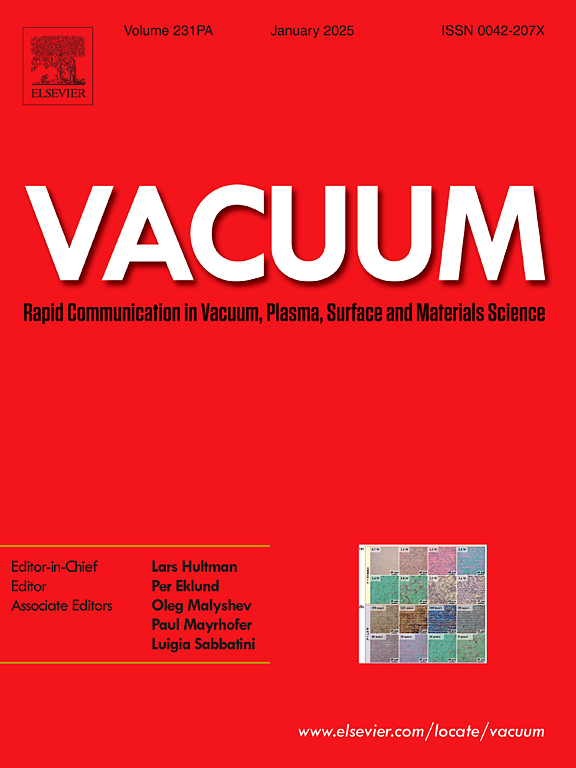暹罗光子源真空系统设计与仿真II:迈向泰国第四代同步加速器光源
IF 3.8
2区 材料科学
Q2 MATERIALS SCIENCE, MULTIDISCIPLINARY
引用次数: 0
摘要
第四代同步加速器光源真空系统的设计受到低发射度晶格空间限制的挑战。本文介绍了用于3.0 GeV Siam光子源II (SPS-II)的集成真空系统,该系统具有紧凑的双三弯消色差(DTBA)晶格。该设计基于一种本地化的泵送理念,将高容量泵集中在光子吸收器附近,并结合使用无油数控加工的铝真空室的先进制造。有限元分析验证了机械设计,表明优化后的支撑系统在热载荷下将临界梁位置的变形保持在0.3 μm以下。对分立铜吸收器的热分析证实,优化的冷却设计使峰值温度低于148°C。三维Molflow +模拟预测,在100 Ah的光束调节后,操作平均压力为1.1 × 10−9毫巴。这项工作表明,在精密制造的支持下,局部抽运策略为第四代光源提供了一个强大而可行的真空解决方案。本文章由计算机程序翻译,如有差异,请以英文原文为准。
Vacuum system design and simulation for Siam Photon Source II: Towards Thailand's fourth-generation synchrotron light source
The design of vacuum systems for fourth-generation synchrotron light sources is challenged by extreme spatial constraints imposed by low-emittance lattices. This paper presents the integrated vacuum system for the 3.0 GeV Siam Photon Source II (SPS-II), which features a compact Double Triple Bend Achromat (DTBA) lattice. The design is based on a localized pumping philosophy that concentrates high-capacity pumps near photon absorbers, combined with advanced fabrication of the aluminum vacuum chambers using oil-less CNC machining. Finite element analysis validates the mechanical design, demonstrating that an optimized support system maintains deformation at critical beam position monitors below 0.3 μm under thermal loads. Thermal analysis of the discrete copper absorbers confirms that an optimized cooling design keeps peak temperatures below 148 °C. Three-dimensional Molflow + simulations predict an operational average pressure of 1.1 × 10−9 mbar after 100 Ah of beam conditioning. This work demonstrates that a localized pumping strategy, supported by precision manufacturing, provides a robust and viable vacuum solution for fourth-generation light sources.
求助全文
通过发布文献求助,成功后即可免费获取论文全文。
去求助
来源期刊

Vacuum
工程技术-材料科学:综合
CiteScore
6.80
自引率
17.50%
发文量
0
审稿时长
34 days
期刊介绍:
Vacuum is an international rapid publications journal with a focus on short communication. All papers are peer-reviewed, with the review process for short communication geared towards very fast turnaround times. The journal also published full research papers, thematic issues and selected papers from leading conferences.
A report in Vacuum should represent a major advance in an area that involves a controlled environment at pressures of one atmosphere or below.
The scope of the journal includes:
1. Vacuum; original developments in vacuum pumping and instrumentation, vacuum measurement, vacuum gas dynamics, gas-surface interactions, surface treatment for UHV applications and low outgassing, vacuum melting, sintering, and vacuum metrology. Technology and solutions for large-scale facilities (e.g., particle accelerators and fusion devices). New instrumentation ( e.g., detectors and electron microscopes).
2. Plasma science; advances in PVD, CVD, plasma-assisted CVD, ion sources, deposition processes and analysis.
3. Surface science; surface engineering, surface chemistry, surface analysis, crystal growth, ion-surface interactions and etching, nanometer-scale processing, surface modification.
4. Materials science; novel functional or structural materials. Metals, ceramics, and polymers. Experiments, simulations, and modelling for understanding structure-property relationships. Thin films and coatings. Nanostructures and ion implantation.
 求助内容:
求助内容: 应助结果提醒方式:
应助结果提醒方式:


